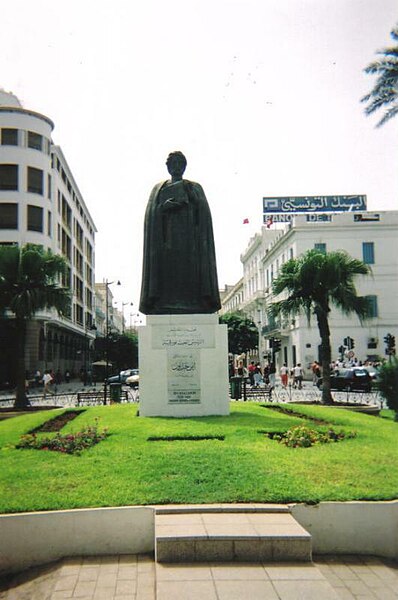History of Islamic economics
Between the 9th and 14th centuries, the Muslim world developed many advanced economic concepts, techniques and usages. These ranged from areas of production, investment, finance, economic development, taxation, property use such as Hawala: an early informal value transfer system, Islamic trusts, known as waqf, systems of contract relied upon by merchants, a widely circulated common currency, cheques, promissory notes, early contracts, bills of exchange, and forms of commercial partnership such as mufawada.
Statue of Ibn Khaldoun in Tunis
A waqf, also called a ḥabs, or mortmain property, is an inalienable charitable endowment under Islamic law. It typically involves donating a building, plot of land or other assets for Muslim religious or charitable purposes with no intention of reclaiming the assets. A charitable trust may hold the donated assets. The person making such dedication is known as a waqif ('donor') who uses a mutawalli ('trustee') to manage the property in exchange for a share of the revenues it generates. In Ottoman Turkish law, and later under the British Mandate of Palestine, a waqf was defined as usufruct state land from which the state revenues are assured to pious foundations. It allows the state to provide social services in accordance with Islamic law while contributing to the preservation of cultural and historical sites. Although the waqf system depended on several hadiths and presented elements similar to practices from pre-Islamic cultures, it seems that the specific full-fledged Islamic legal form of endowment called waqf dates from the 9th century AD.

Endowment Deed of Mihrimah Sultan. This document concerns the endowment of properties in Anatolia and Rumelia, from which revenues were used to meet the expenses of the Mihrimah Sultan Mosque complex. April–March 1550. Sadberk Hanım Museum
Waqf Writing Room in Mevlana Museum
Uthman waqf (Medina)
Endowment Charter (Waqfiyya) of Hürrem Sultan. The deed mentioned the buildings known from later sources as the Haseki Hürrem Sultan Mosque, Madrasa and Imaret (soup-kitchen), and contain a detailed explanation as to how expenditures will be made to take care of the endowment's operations, such as the care and cleaning of the buildings, the salaries of the people who worked in them, and so forth. AD 1556-1557 (AH 964). Museum of Turkish and Islamic Arts





